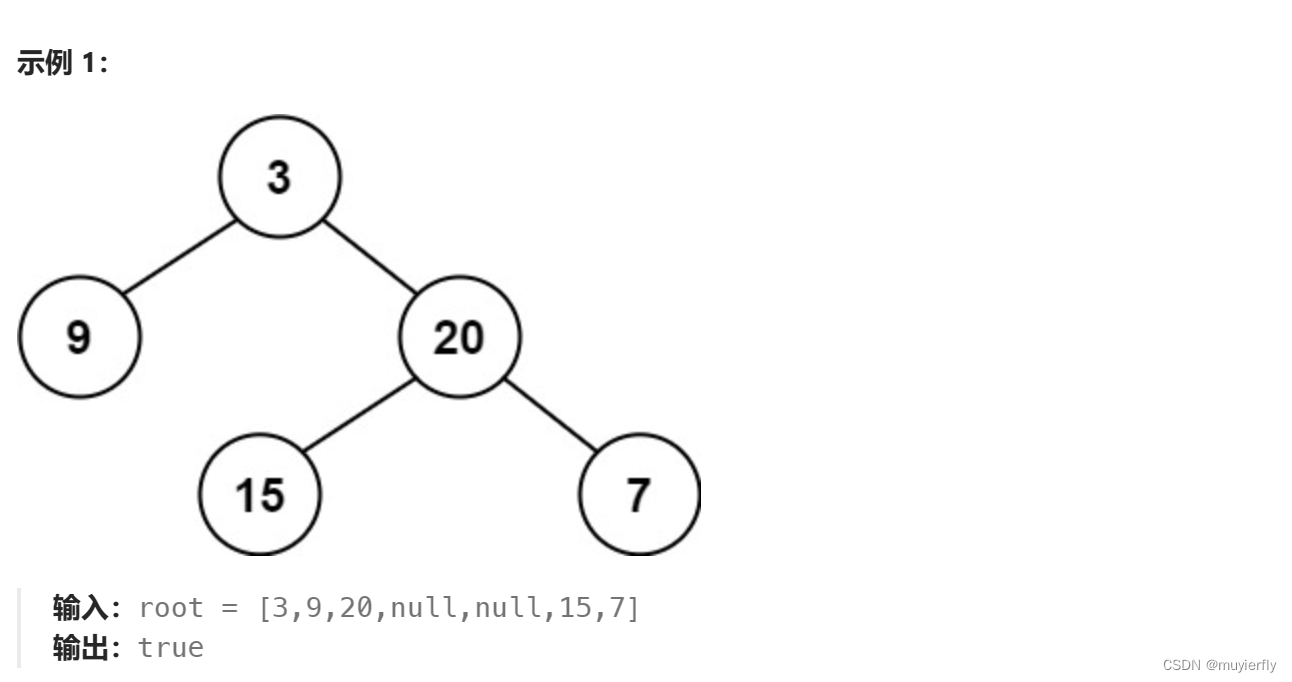1.平衡二叉树
给定一个二叉树,判断它是否是 平衡二叉树

java
class Solution {
public int getHeight(TreeNode root) {
if(root == null)
return 0;
int leftHeight = getHeight(root.left);
int rightHeight = getHeight(root.right);
if(leftHeight>=0&&rightHeight>=0&&Math.abs(leftHeight-rightHeight)<=1){
return Math.max(leftHeight,rightHeight)+1;
}else{
return -1;
}
}
public boolean isBalanced(TreeNode root) {
if(root==null){
return true;
}
return getHeight(root)>=0;
}
}2.二叉树的最小深度
给定一个二叉树,找出其最小深度。
最小深度是从根节点到最近叶子节点的最短路径上的节点数量。
**说明:**叶子节点是指没有子节点的节点。
java
class Solution {
public int minDepth(TreeNode root) {
if (root == null) {
return 0;
}
if (root.left == null && root.right == null) {
return 1;
}
int min_depth = Integer.MAX_VALUE;
if (root.left != null) {
min_depth = Math.min(minDepth(root.left), min_depth);
}
if (root.right != null) {
min_depth = Math.min(minDepth(root.right), min_depth);
}
return min_depth + 1;
}
}3.路经总和
方法一:广度优先搜索
java
class Solution {
public boolean hasPathSum(TreeNode root, int sum) {
if (root == null) {
return false;
}
Queue<TreeNode> queNode = new LinkedList<TreeNode>();
Queue<Integer> queVal = new LinkedList<Integer>();
queNode.offer(root);
queVal.offer(root.val);
while (!queNode.isEmpty()) {
TreeNode now = queNode.poll();
int temp = queVal.poll();
if (now.left == null && now.right == null) {
if (temp == sum) {
return true;
}
continue;
}
if (now.left != null) {
queNode.offer(now.left);
queVal.offer(now.left.val + temp);
}
if (now.right != null) {
queNode.offer(now.right);
queVal.offer(now.right.val + temp);
}
}
return false;
}
}方法二:递归
java
class Solution {
public boolean hasPathSum(TreeNode root, int sum) {
if (root == null) {
return false;
}
if (root.left == null && root.right == null) {
return sum == root.val;
}
return hasPathSum(root.left, sum - root.val) || hasPathSum(root.right, sum - root.val);
}
}4.路经总和2
给你二叉树的根节点 root 和一个整数目标和 targetSum ,找出所有 从根节点到叶子节点 路径总和等于给定目标和的路径。
叶子节点 是指没有子节点的节点。

方法一:深度优先搜索
java
class Solution {
List<List<Integer>> ret = new LinkedList<List<Integer>>();
Deque<Integer> path = new LinkedList<Integer>();
public List<List<Integer>> pathSum(TreeNode root, int targetSum) {
dfs(root, targetSum);
return ret;
}
public void dfs(TreeNode root, int targetSum) {
if (root == null) {
return;
}
path.offerLast(root.val);
targetSum -= root.val;
if (root.left == null && root.right == null && targetSum == 0) {
ret.add(new LinkedList<Integer>(path));
}
dfs(root.left, targetSum);
dfs(root.right, targetSum);
path.pollLast();
}
}方法二:广度优先搜索
java
class Solution {
List<List<Integer>> ret = new LinkedList<List<Integer>>();
Map<TreeNode, TreeNode> map = new HashMap<TreeNode, TreeNode>();
public List<List<Integer>> pathSum(TreeNode root, int targetSum) {
if (root == null) {
return ret;
}
Queue<TreeNode> queueNode = new LinkedList<TreeNode>();
Queue<Integer> queueSum = new LinkedList<Integer>();
queueNode.offer(root);
queueSum.offer(0);
while (!queueNode.isEmpty()) {
TreeNode node = queueNode.poll();
int rec = queueSum.poll() + node.val;
if (node.left == null && node.right == null) {
if (rec == targetSum) {
getPath(node);
}
} else {
if (node.left != null) {
map.put(node.left, node);
queueNode.offer(node.left);
queueSum.offer(rec);
}
if (node.right != null) {
map.put(node.right, node);
queueNode.offer(node.right);
queueSum.offer(rec);
}
}
}
return ret;
}
public void getPath(TreeNode node) {
List<Integer> temp = new LinkedList<Integer>();
while (node != null) {
temp.add(node.val);
node = map.get(node);
}
Collections.reverse(temp);
ret.add(new LinkedList<Integer>(temp));
}
}5.二叉树展开为链表
方法一:前序遍历
java
class Solution {
public void flatten(TreeNode root) {
List<TreeNode> list = new ArrayList<TreeNode>();
Deque<TreeNode> stack = new LinkedList<TreeNode>();
TreeNode node = root;
while (node != null || !stack.isEmpty()) {
while (node != null) {
list.add(node);
stack.push(node);
node = node.left;
}
node = stack.pop();
node = node.right;
}
int size = list.size();
for (int i = 1; i < size; i++) {
TreeNode prev = list.get(i - 1), curr = list.get(i);
prev.left = null;
prev.right = curr;
}
}
}方法二:寻找前驱节点
java
class Solution {
public void flatten(TreeNode root) {
TreeNode curr = root;
while (curr != null) {
if (curr.left != null) {
TreeNode next = curr.left;
TreeNode predecessor = next;
while (predecessor.right != null) {
predecessor = predecessor.right;
}
predecessor.right = curr.right;
curr.left = null;
curr.right = next;
}
curr = curr.right;
}
}
}